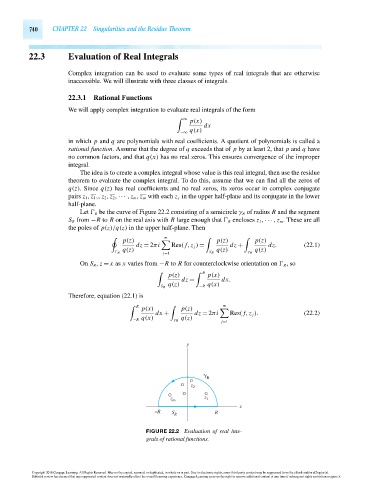Page 760 - Advanced_Engineering_Mathematics o'neil
P. 760
740 CHAPTER 22 Singularities and the Residue Theorem
22.3 Evaluation of Real Integrals
Complex integration can be used to evaluate some types of real integrals that are otherwise
inaccessible. We will illustrate with three classes of integrals.
22.3.1 Rational Functions
We will apply complex integration to evaluate real integrals of the form
∞
p(x)
dx
−∞ q(x)
in which p and q are polynomials with real coefficients. A quotient of polynomials is called a
rational function. Assume that the degree of q exceeds that of p by at least 2, that p and q have
no common factors, and that q(x) has no real zeros. This ensures convergence of the improper
integral.
The idea is to create a complex integral whose value is this real integral, then use the residue
theorem to evaluate the complex integral. To do this, assume that we can find all the zeros of
q(z). Since q(z) has real coefficients and no real zeros, its zeros occur in complex conjugate
pairs z 1 , z 1 ,, z 2 , z 2 , ··· , z m , z m with each z j in the upper half-plane and its conjugate in the lower
half-plane.
Let R be the curve of Figure 22.2 consisting of a semicircle γ R of radius R and the segment
S R from −R to R on the real axis with R large enough that R encloses z 1 ,··· , z m . These are all
the poles of p(z)/q(z) in the upper half-plane. Then
m
p(z) p(z) p(z)
dz = 2πi Res( f, z j ) = dz + dz. (22.1)
q(z) q(z) q(z)
R S R γ R
j=1
On S R , z = x as x varies from −R to R for counterclockwise orientation on R ,so
p(z) p(x)
R
dz = dx.
q(z) −R q(x)
S R
Therefore, equation (22.1) is
p(x) p(z)
R m
dx + dz = 2πi Res( f, z j ). (22.2)
−R q(x) q(z)
γ R
j=1
y
R
z 2
z m z 1
x
–R S R R
FIGURE 22.2 Evaluation of real inte-
grals of rational functions.
Copyright 2010 Cengage Learning. All Rights Reserved. May not be copied, scanned, or duplicated, in whole or in part. Due to electronic rights, some third party content may be suppressed from the eBook and/or eChapter(s).
Editorial review has deemed that any suppressed content does not materially affect the overall learning experience. Cengage Learning reserves the right to remove additional content at any time if subsequent rights restrictions require it.
October 14, 2010 15:37 THM/NEIL Page-740 27410_22_ch22_p729-750

